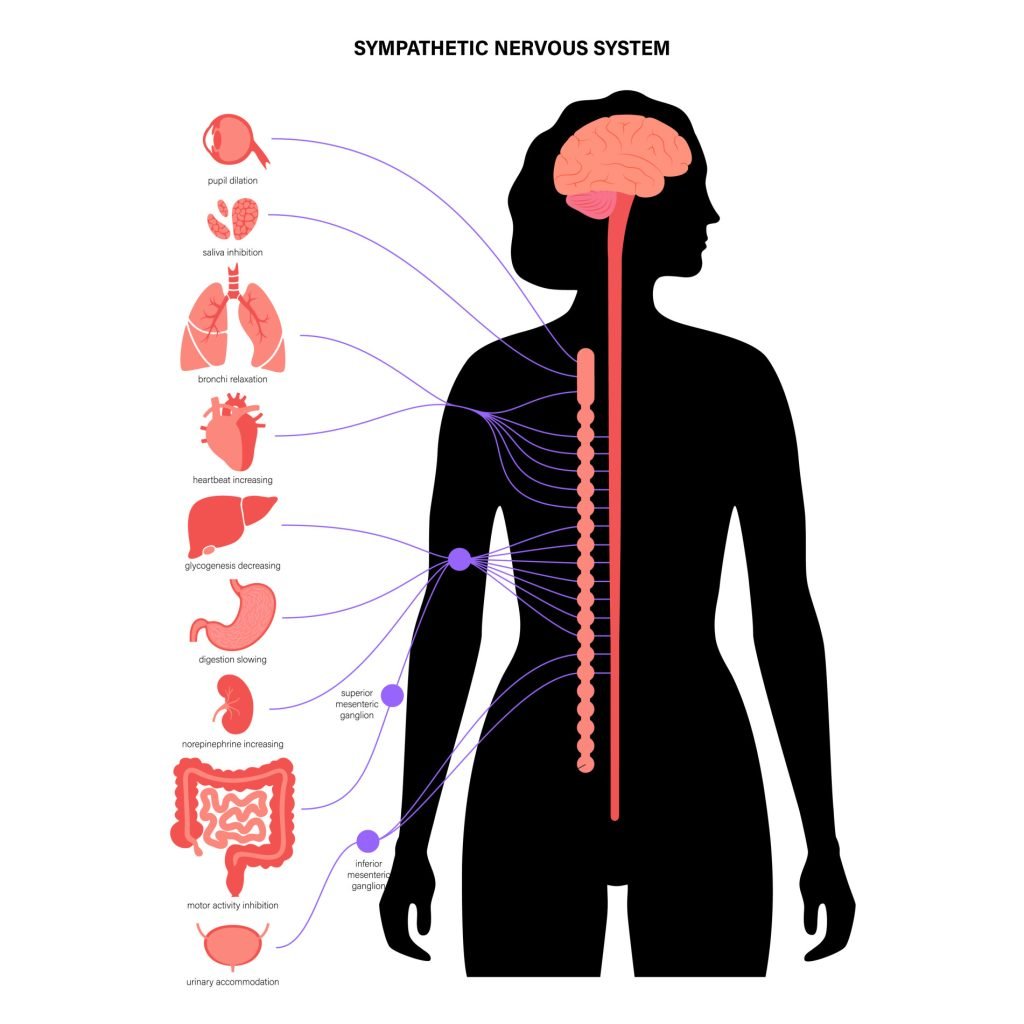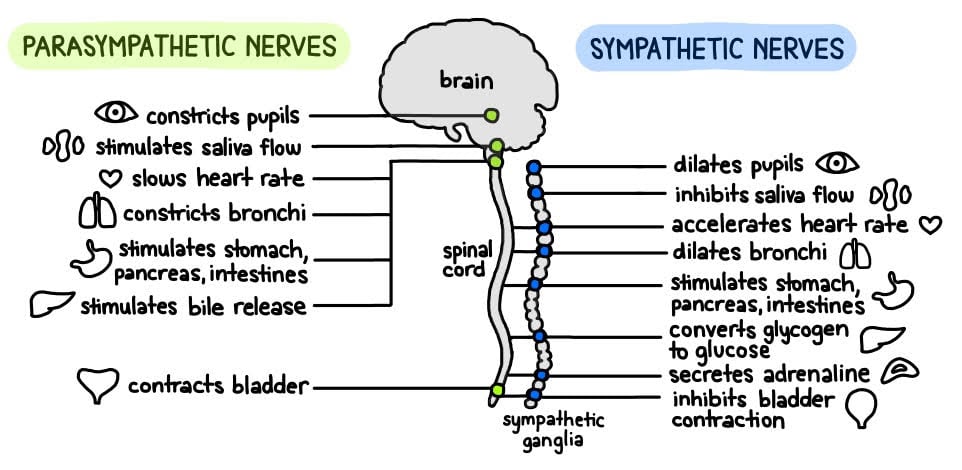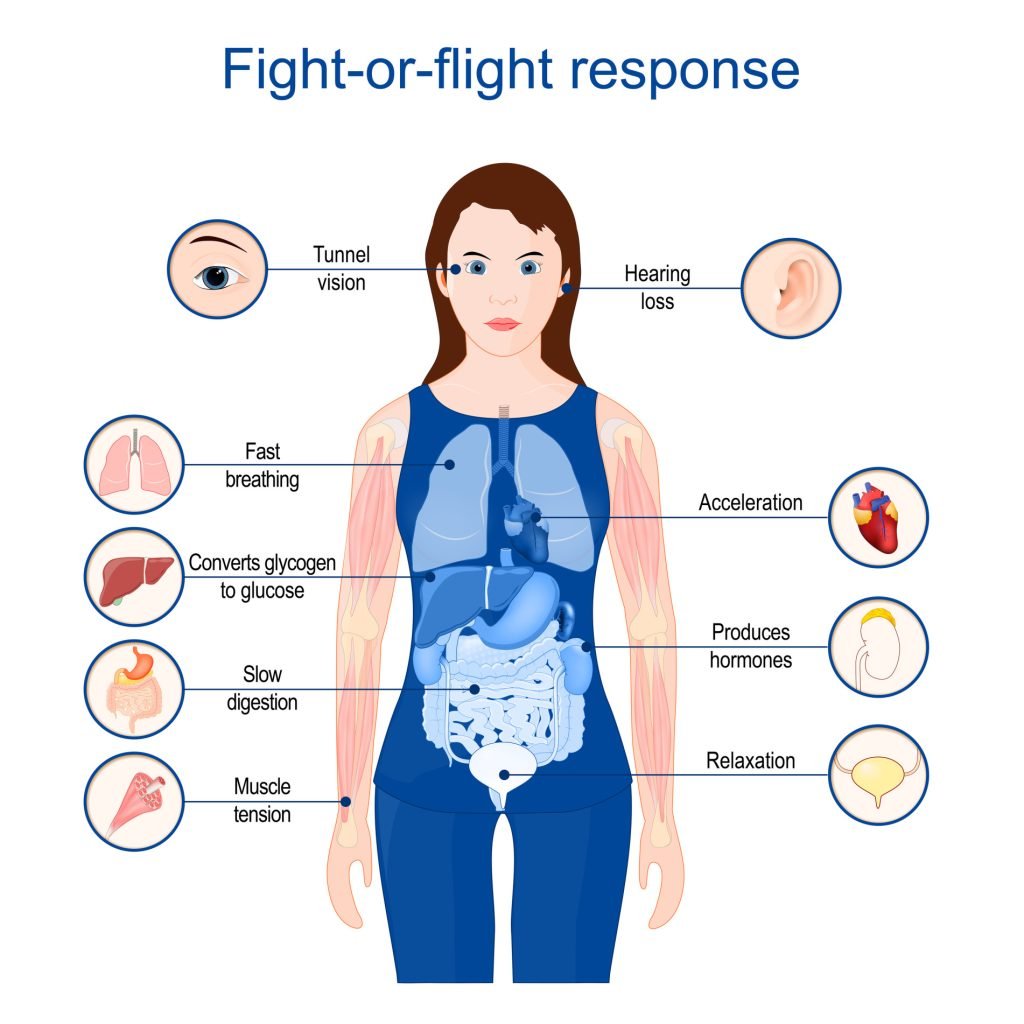On This Page:
The sympathetic nervous system (SNS) is a subdivision of the autonomic nervous system that regulates autonomic processes. The sympathetic nervous system is involved in preparing the body for stress-related activities, and it slows bodily processes that are less important in emergencies, such as digestion.
These processes are not under direct conscious control, occurring automatically and without conscious thought.

The sympathetic nervous system is typically recruited in situations requiring quick responses.
- Increase heart rate
- Dilation of the pupils
- Secretion of sweat glands
- Dilated muscles
- Increase alertness
- Slowing down or stopping digestion
- Relaxation of the bladder
The SNS can maintain homeostasis through actions such as sweating to cool down the body or in regulating heart rate. In contrast to the parasympathetic nervous system, which slows down physiological processes, the SNS typically stimulates organs.
The parasympathetic branch, however, stimulates digestion and the urinary system when relaxed, whereas the SNS slows them down as these processes are not required during heightened stress.
The SNS also works alongside the parasympathetic nervous system to maintain homeostasis – the balance of internal physiological mechanisms essential for all living organisms.
Essentially, the parasympathetic branch is the antagonist of the SNS. Also, the neurons of the SNS have shorter pathways in comparison to those of the parasympathetic nervous system. This shorter distance allows for a quicker signal transmission; sometimes the responses happen before a person is consciously aware of them.

What does the sympathetic nervous system do?
Fight-or-flight Response
The primary function of the SNS is to activate the fight-or-flight response in threatening situations. For instance, if you are walking alone down a dark street at night and a stranger approaches you, your body responds in a way to enable you to either fight or run away from the situation.

In this situation, the SNS would trigger responses such as causing the eyes to dilate and the heart to beat faster. These autonomic responses to a threatening situation are, therefore, essential for survival. In evolutionary terms, the SNS would have been used in order to fight or escape predators and for hunting to eat and survive.
More modern-day stressors can also stimulate the SNS, such as financial pressures, stresses at work, or anything that can cause high anxiety for individuals.
When a stressful or anxiety-provoking situation arises, the amygdala (an area of the brain associated with fear and emotions) sends a distress signal to the hypothalamus (a command structure of the brain associated with maintaining homeostasis).
Impulses are then transmitted through the SNS to the adrenal glands, which then pump adrenaline, and then cortisol (stress hormone), into the bloodstream.
This will then bring about the physiological changes needed to be prepared to either fight or flight.
The reactions brought about by the SNS result in heightened awareness and preparation for combat or running. Fundamentally, the fight-or-flight response is mediated via impulses transmitted throughout the SNS to the adrenal glands.
The adrenal glands facilitate both short-term responses to stress as well as long-term responses.
Once the threat has been resolved, the parasympathetic nervous system takes over and returns bodily
functions to a relaxed state.
Regulating Body Temperature
For homeostasis to be achieved, the SNS can control the body temperature of organisms through the use of fat reserves in the body.
The SNS uses these reserves to increase the production of heat and through changing the flow of blood to the skin.
The SNS is also able to stimulate the sweat glands to enable the body to cool down, as well as being able to stimulate fatty acid release to instigate long-term responses to persistent periods of cold.
Cardiovascular Effects
The SNS can have effects on the cardiovascular system within the body. This comes into play when exercising (when heart rate needs to increase), changing posture (e.g., going from a sitting to a standing position), and when transitioning from sleep to wakefulness.
These changes via the SNS are necessary, especially when changing positions; otherwise, this can cause dizziness and fainting.
Nerves of the SNS
The SNS consists of neurons found within the peripheral nervous system and the central nervous system, which usually works in stimulating the body’s organs in response to fear or stress.
There are two types of neurons within the sympathetic nervous system: preganglionic and postganglionic neurons, or ganglion cells.

The word ‘ganglia’ refers to clusters of neurons outside the brain and spinal cord. Instead, they are part of the autonomic nervous system and run alongside the spinal cord.
The preganglionic neurons originate in the brain stem or spinal cord and will always leave the spinal cord through areas called the thoracic and lumbar regions.
The preganglionic neurons will then synapse with the postganglionic neurons at ganglia, which sit outside of the spinal cord.
The postganglionic neurons will then extend to target organs of the SNS (e.g., heart, sweat glands, and stomach) in order to trigger certain effects when activated.
Neurotransmitters within the SNS
Neurotransmitters are the chemical messengers which are transmitted through neurons. The preganglionic neuron’s primary neurotransmitter is acetylcholine.
Acetylcholine is a neurotransmitter found in both the central nervous system and the peripheral nervous system and plays a role in brain and muscle function.
The preganglionic neurons within the thoracic and lumbar regions in the spinal cord carry acetylcholine, making them cholinergic, and release it at synapses within the ganglia.
Acetylcholine is then taken up by the receptors on the postganglionic neurons. Activation of this process results in signals being extended to target areas of the sympathetic nervous system and the release of another neurotransmitter called norepinephrine.
Norepinephrine (also known as noradrenaline) is an excitatory neurotransmitter as it stimulates the body. This chemical helps in activating the body and brain to act during the fight-or-flight response, aiding in alertness.
Norepinephrine is released from the adrenal medulla after prolonged activation from postganglionic neurons. Epinephrine (also known as adrenaline) is also released from the adrenal medulla after increased levels of activation.
Epinephrine is also an excitatory neurotransmitter that is released into the bloodstream and enhances the neuronal effects of the SNS. As a result, these neurotransmitters encourage the organs involved in the SNS to respond to a threat and cause blood vessels to dilate, or open up, to allow more blood flow in order for the muscles to fight or flight. This process is called vasodilation.
In other words, a perceived threat results in the secretion of epinephrine and norepinephrine from the adrenal medulla, which then acts on several organs and the cardiovascular system to mediate the fight-or-flight response.
Problems with the SNS
Although most modern-day stressors which trigger the SNS may appear small, they may be interpreted by our nervous system as a potential life threat.
If the SNS is activated too frequently, this can have long-lasting effects on the body, resulting in chronic stress. Similarly, constant surges of epinephrine can damage blood vessels and arteries, which in turn can increase blood pressure and increase the risk of strokes and heart attacks.
Alternatively, if the SNS is under-functioning, this can also cause issues. If someone’s SNS is not functioning, they may not have appropriate responses in times of stress.
They may not recognize that there is a danger, and they may take more risks as they are not being alerted by their SNS that they are in life-threatening situations.
As their organs are not receiving signals to fight-or-flight, this may result in being under-prepared in these situations, due to lack of blood being pumped around the body or other systems failing to be recruited.
Autonomic dysfunction is a condition whereby the autonomic nervous system and its divisions do not work properly.
This may lead to altered functioning of the heart, sweat glands, pupils, and blood vessels, depending on the condition. Autonomic dysfunction can develop when nerves of the autonomic nervous system are damaged and can range from mild to life-threatening.
The most common cause of autonomic dysfunction is diabetes, but there could be hereditary reasons, as well as aging, Parkinson’s disease, or chronic fatigue syndrome being some of the possible causes.
If someone believes they may be suffering from autonomic dysfunction, they may be experiencing one or more of the following symptoms:
- Feeling dizziness or actually fainting.
- Inability to alter heart rate in response to exercise.
- Abnormally fast heart rate.
- Digestive issues.
- Visual problems, e.g. blurriness.
- Abnormal sweating – either too much sweating or not sweating enough.
- Lack of pupillary response.
Autonomic dysfunction can be treated depending on the symptoms being experienced. For instance, if the cause of dysfunction is due to diabetes, controlling blood sugar will be the primary treatment.
In many cases, treatment of the underlying disease (if applicable) can allow damaged nerves within the ANS to repair and regenerate.
Autonomic dysfunction can be diagnosed through a doctor, using measures such as blood pressure and heart rate, in order to understand what exactly the issue is.
How to calm an overactive sympathetic nervous system
If an individual has an overactive SNS in times that are not considered dangerous, there are quick methods that can somewhat aid in calming down the SNS.
Taking deep breaths at a slow and steady pace, as well as various breathing exercises, are ways to encourage our parasympathetic nervous system to antagonize the SNS. This can be a quick way to help manage stress responses and decrease anxiety.
Similarly, practicing mindfulness is another method to actively prompt the body to rest, rejuvenate and regenerate, allowing a return to homeostasis.
For more serious cases of chronic stress, deep breathing may not be useful, so it is recommended to seek a doctor’s advice, who may recommend medical treatment or therapies to be able to combat the cause of the stress.
References
Biology Dictionary. (October 4, 2019). Sympathetic Nervous System. https://biologydictionary.net/sympathetic-nervous-system/
Britannica, T. Editors of Encyclopaedia (2019, September 13). Sympathetic nervous system. Encyclopedia Britannica. https://www.britannica.com/science/sympathetic-nervous-system
Lumen. (n.d.). Functions of the Autonomic Nervous System. Retrieved May 5, 2021 from https://courses.lumenlearning.com/boundless-ap/chapter/functions-of-the-autonomic-nervous-system/


